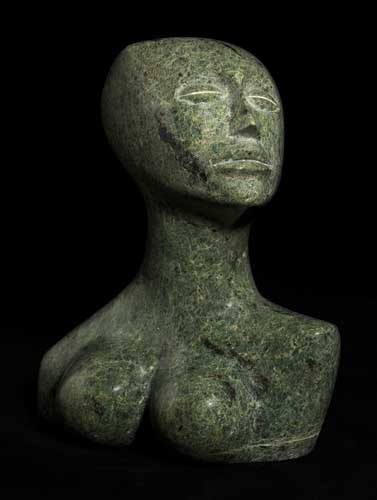Sale 2136 - Lot 150
Unsold
Estimate: $ 150,000 - $ 200,000
ELIZABETH CATLETT (1915 - )
Sister.
Green marble, 1971. Approximately 330x280x190 mm; 13x11x7 1/2 inches. Initialed "EC" at the rear lower edge.
Provenance: Acquired directly from the artist, 1972; private collection, New York.
Exhibited: Elizabeth Catlett: Prints and Sculpture, Studio Museum in Harlem, New York, NY, September 26, 1971- January 9, 1972, with the label affixed to the bottom of the sculpture; Elizabeth Catlett: A Fifty-Year Retrospective, the Neuberger Museum of Art, SUNY-Purchase, Purchase, NY, 1998.
The Studio Museum exhibition was the artist's first solo exhibiton in the United States since 1948. Catlett had also not visited the United States since 1961 due to her being labeled a Communist, and the hostile reception of the U.S. embassy in Mexico. Her visa was granted in 1971 only after a year long campaign, and was restricted to her attending the opening and an approved itinerary. The sculpture was acquired by the current owner shortly after this New York exhibition.
Illustrated: Lucinda Gedeon, Elizabeth Catlett: A Fifty-Year Retrospective, the Neuberger Museum of Art, Purchase, NY, 1998; Melanie Ann Herzog. Elizabeth Catlett: An American Artist in Mexico. Seattle: University of Washington Press, plate 10.
Sister is both a product of her times and a timeless beauty. This Mexican marble has the same simplified pose of Catlett's Political Prisoner and other works, but in tandem with its title, it takes on new cultural meaning. Herzog describes this work in detail -
"Carved in green Mexican marble in 1971, this bust is elegant in the strength of its simplicity, with beautifully organic curves that define its generalized shapes. The upturned face recalls the face of Mujer, but Sister's title suggests an African-American woman's identity and outlook. The eyes and nose of Sister are similar in their geometrization to those of the faces in Black Unity, but she has carefully defined a naturalistic mouth that gives particularity to this expression of black pride."
The exotic and translucent material of green Mexican marble also relates the bust to ancient Olmec sculpture. Catlett's work in marble, onyx and mahogany are all chosen to bring out the most of the material's inherent beauty, and relate the work to their historical sources - African or Mexican. Catlett herself has stated "I like to finish sculpture to the maximum beauty attainable from the material from which it is created." Herzog p. 154; Stokes-Sims, p. 4.
Sister.
Green marble, 1971. Approximately 330x280x190 mm; 13x11x7 1/2 inches. Initialed "EC" at the rear lower edge.
Provenance: Acquired directly from the artist, 1972; private collection, New York.
Exhibited: Elizabeth Catlett: Prints and Sculpture, Studio Museum in Harlem, New York, NY, September 26, 1971- January 9, 1972, with the label affixed to the bottom of the sculpture; Elizabeth Catlett: A Fifty-Year Retrospective, the Neuberger Museum of Art, SUNY-Purchase, Purchase, NY, 1998.
The Studio Museum exhibition was the artist's first solo exhibiton in the United States since 1948. Catlett had also not visited the United States since 1961 due to her being labeled a Communist, and the hostile reception of the U.S. embassy in Mexico. Her visa was granted in 1971 only after a year long campaign, and was restricted to her attending the opening and an approved itinerary. The sculpture was acquired by the current owner shortly after this New York exhibition.
Illustrated: Lucinda Gedeon, Elizabeth Catlett: A Fifty-Year Retrospective, the Neuberger Museum of Art, Purchase, NY, 1998; Melanie Ann Herzog. Elizabeth Catlett: An American Artist in Mexico. Seattle: University of Washington Press, plate 10.
Sister is both a product of her times and a timeless beauty. This Mexican marble has the same simplified pose of Catlett's Political Prisoner and other works, but in tandem with its title, it takes on new cultural meaning. Herzog describes this work in detail -
"Carved in green Mexican marble in 1971, this bust is elegant in the strength of its simplicity, with beautifully organic curves that define its generalized shapes. The upturned face recalls the face of Mujer, but Sister's title suggests an African-American woman's identity and outlook. The eyes and nose of Sister are similar in their geometrization to those of the faces in Black Unity, but she has carefully defined a naturalistic mouth that gives particularity to this expression of black pride."
The exotic and translucent material of green Mexican marble also relates the bust to ancient Olmec sculpture. Catlett's work in marble, onyx and mahogany are all chosen to bring out the most of the material's inherent beauty, and relate the work to their historical sources - African or Mexican. Catlett herself has stated "I like to finish sculpture to the maximum beauty attainable from the material from which it is created." Herzog p. 154; Stokes-Sims, p. 4.

Exhibition Hours
Exhibition Hours
Aliquam vulputate ornare congue. Vestibulum maximus, libero in placerat faucibus, risus nisl molestie massa, ut maximus metus lectus vel lorem.


